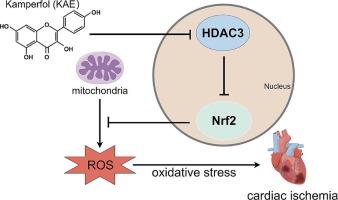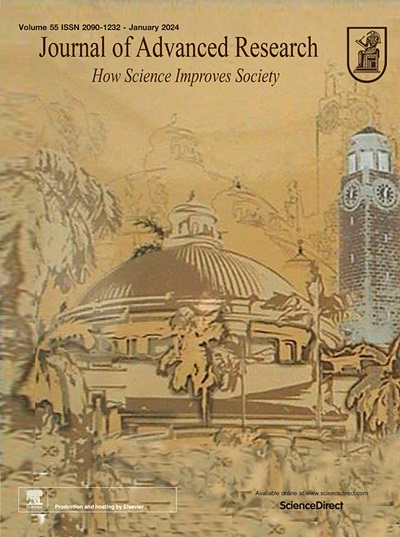堪非醇通过 HDAC3 介导的 Nrf2 信号通路减少氧化应激,从而减轻心肌缺血损伤
IF 11.4
1区 综合性期刊
Q1 MULTIDISCIPLINARY SCIENCES
引用次数: 0
摘要
导言堪非醇(KAE)是一种存在于多种植物中的类黄酮。最近的研究表明,从膳食中摄入大量 KAE 与降低心肌梗死的风险有关;然而,KAE 的心脏保护机制仍不清楚。方法用不同剂量的 KAE 预处理雄性大鼠 14 天,然后注射 ISO 诱导心肌缺血损伤。结果我们发现,KAE 预处理能显著减轻 ISO 注射大鼠的心肌损伤并改善心功能。此外,KAE 还通过降低丙二醛浓度、提高超氧化物歧化酶活性和保护心肌线粒体结构来减轻心肌缺血大鼠的氧化应激。KAE 还能通过抑制氧化应激减轻 CoCl2 诱导的 H9c2 心肌细胞损伤。在机制方面,我们发现 KAE 下调了 ISO 诱导的大鼠和 CoCl2 刺激的心肌细胞中 HDAC3 的表达,并上调了 Nrf2 的表达。用 HDAC3 选择性抑制剂 RGFP966 培养心肌细胞可增强 KAE 的保护作用并减少氧化应激。相反,与 KAE 处理组相比,通过腺病毒过表达 HDAC3 可减轻 KAE 对氧化应激的影响。在使用 RGFP966 或过表达 HDAC3 的腺病毒的心肌细胞中,HDAC3 还能调控 Nrf2 的表达;但抑制 Nrf2 会降低 KAE 对 CoCl2 诱导的心肌细胞中 ROS 生成的影响。免疫沉淀分析表明,HDAC3 与心肌细胞中的 Nrf2 相互作用。结论我们的数据表明,KAE 可通过 HDAC3 介导的 Nrf2 信号通路减少心肌细胞中的氧化应激,从而改善心脏损伤。本文章由计算机程序翻译,如有差异,请以英文原文为准。

Kaempferol alleviates myocardial ischemia injury by reducing oxidative stress via the HDAC3-mediated Nrf2 signaling pathway
Introduction
Kaempferol (KAE) is a flavonoid found in various plants. Recent studies showed that high dietary intake of KAE was associated with a lower risk of myocardial infarction; however, the cardioprotective mechanism of KAE remains unknown.Objectives
To determine the effect of KAE on cardiac injury in isoproterenol (ISO)-induced rats and cobalt chloride (CoCl2)-treated cardiomyocytes, and the underlying mechanisms.Methods
Male rats were pretreated with different doses of KAE for 14 days, and then injected with ISO to induce myocardial ischemia injury. We also established a model of myocardial cell injury using rat H9c2 cardiomyocytes stimulated with CoCl2.Results
We found that KAE pretreatment significantly alleviated myocardial injury and improved cardiac function in ISO-injected rats. In addition, KAE reduced oxidative stress in rats with myocardial ischemia by decreasing malondialdehyde concentration and increasing superoxide dismutase activity, and protection of the myocardial mitochondrial structure. KAE also attenuated CoCl2-induced injury of H9c2 cardiomyocytes via suppression of oxidative stress. With regard to the mechanism, we found that KAE down-regulated HDAC3 expression and up-regulated Nrf2 expression in ISO-induced rats and CoCl2-stimulated cardiomyocytes. Incubation of cardiomyocytes with HDAC3-selective inhibitor RGFP966 augmented the protective effect of KAE and reduced oxidative stress. By contrast, HDAC3 overexpression by adenovirus attenuated the effect of KAE on oxidative stress compared with KAE treatment group. HDAC3 also regulated Nrf2 expression in the cardiomyocytes with RGFP966 or an adenovirus overexpressing HDAC3; but Nrf2 inhibition reduced the effect of KAE on ROS generation in CoCl2-induced cardiomyocytes. Immunoprecipitation assay showed that HDAC3 interacted with Nrf2 in cardiomyocytes. Further studies found that KAE increased the acetylation level of Nrf2, while HDAC3 overexpression decreased the acetylation of Nrf2 compared with KAE treatment group.Conclusion
Our data show that KAE ameliorates cardiac injury by reducing oxidative stress via the HDAC3-mediated Nrf2 signaling pathway in cardiomyocytes.求助全文
通过发布文献求助,成功后即可免费获取论文全文。
去求助
来源期刊

Journal of Advanced Research
Multidisciplinary-Multidisciplinary
CiteScore
21.60
自引率
0.90%
发文量
280
审稿时长
12 weeks
期刊介绍:
Journal of Advanced Research (J. Adv. Res.) is an applied/natural sciences, peer-reviewed journal that focuses on interdisciplinary research. The journal aims to contribute to applied research and knowledge worldwide through the publication of original and high-quality research articles in the fields of Medicine, Pharmaceutical Sciences, Dentistry, Physical Therapy, Veterinary Medicine, and Basic and Biological Sciences.
The following abstracting and indexing services cover the Journal of Advanced Research: PubMed/Medline, Essential Science Indicators, Web of Science, Scopus, PubMed Central, PubMed, Science Citation Index Expanded, Directory of Open Access Journals (DOAJ), and INSPEC.
 求助内容:
求助内容: 应助结果提醒方式:
应助结果提醒方式:


